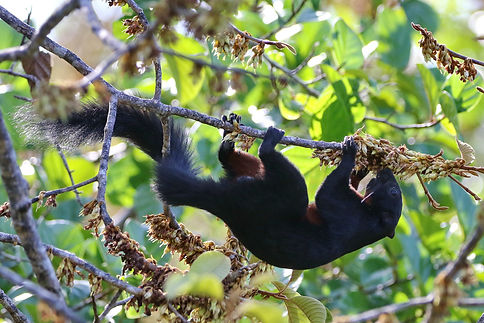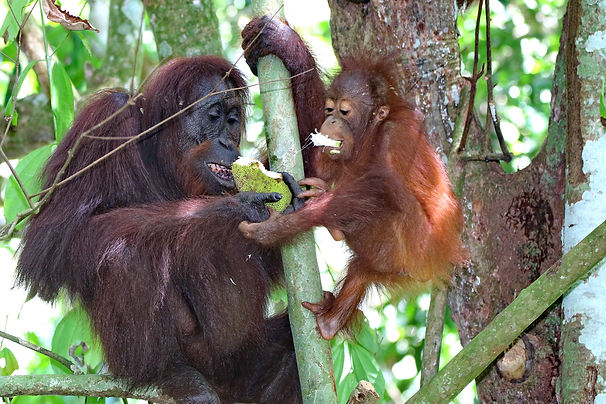
Malaysia
Sabah
Sabah is the north-eastern province of malaysian Borneo and home to an astonishing variety of wildlife. In May/June 2024 we have been able to spend three weeks in Sabah flying in and out of Kota Kinabalu and using a rental car for transport. The following sites have been visited: Tanjung Aru in Kota Kinabalu (short stop only before a flight), Gunung Alab and Kinabalu NP (2 resp. 5 days, both high altitude 1500 - 2000 m), Poring (2 days, 500 - 800 m altitude), RDC in Sepilok and Bilit on the Kinabatangan River (5 days each, both in the steaming lowlands). Apart from a swift eating monkey in Gunung Alab, all our mammal sightings occured in the lowlands. Highlights were eight different primate species including several orang utan encounters and a herd of bornean pygmy elefants.


Gunung Alab is an 2 h drive from Kota Kinabalu at almost 2000 m altitude in the Crocker mountains. The restaurant opposite to the park headquarter access road attracted a large number of nesting swiftlets. While enjoying a lunch a big long-tailed macaque appeared, rather unexpectedly at this altitude. It altered the usual vegetarian diet to swiftlet nestlings, of which he grabbed several and then happily devoured them.

With the exception of a number of sqirrels and a malayan weasel in the fog of a Kinabalu morning all our mammal sightings happened in the lowlands. Our main focus was to encounter as many as possible of Sabah's monkey species and of cause orang utans.
There are few deer species in Borneo and none is very numerous and easy to spot. Our only sighting was this group of sambar deer grazing on an open area near the lodge at Poring.




On the other hand an impressive number of squirrel species lives in Borneo. This prevost squirrel was seen in the canopy from a tower of the RDC Sepilok skywalk. Out of several colour variations this dark form arguably is the most pretty.
Giant squirrels are large with a weight of up to 1.5 kg. The bornean individuals - like this one from Sepilok - are often darker in colour than in other regions.
During a night walk at RDC in Sepilok red giant flying sqirrels can usually be seen. They can reach 2 kg in weight and some are using nest boxes high on trees. This squirrel took a look out of one of the boxes before dark. The radio collared individual below later showed an impressive 80m glide using its patagium membrane (still folded here in the picture).


With a little luck two unique nocturnal primates can be seen during a night walk at RDC:
Pygmy slow loris are - as the name suggests - moving slowly in their jungle home looking for fruit, eggs and insects. They are the old world counterpart of neotropical sloths and the only poisonous primate. The poison is licked from an elbow gland and the lori can deliver a very painful and even dangerous bite. Unfortunately these cute looking animals pay a heavy toll to the pet trade and are endangered today.


Horsefield's or western tarsiers are the only purely carniverous primates. They are strictly nocturnal and eat insects with the occasional bird, bat or even poisonous snake. These tiny primates are very agile jumpers and in many respects the convergent counterpart of africa's bushbabies.

Long-tailed macaques are very common, both at RDC and Kinabatangan. Main diet are fruits with flowers, leaves and other plants materials as well as insects, fish and even birds (see above) taken.



Southern pig tailed macaques consume the same diet as their long-tailed cousins. They are however terrestrial to a larger extend and love water. Classified endangered throughout their home range in peninsular Malaysia, Sumatra and Borneo, the species is still common along the Kinabatangan river.

Northern grey gibbons inhabit mature forests in the northern half of Borneo. Also classified endangered we heard their songs frequently at RDC and Kinabatangan. Our only sighting was from the RDC skywalk, a group eating orchids. Main diet of these agile arboreal primates are fruits, but other plant materials and occasionally insects and eggs are also consumed.


The forests bordering the Kinabatangan river are incredibly rich in primates both considering number of species and individuals. Silvery langurs are almost exclusively leaf eaters. They are a peaceful arboreal species living in harem groups, their babies are brightly orange coloured.


Maroon langurs (seen near the Gomantong caves) are another vulnerable and strictly arboreal species. These attractive monkeys are restricted to less disturbed forests in Borneo. In addition to leafs of a relative small number of specific trees, fruits are consumed when available.


Proboscis monkeys are an endangered leaf eating mangrove specialist, endemic to Borneo. They are easily seen during boat trips on the Kinabatangan.

Male proboscis with their spectacular huge noses oversee a harem, they can reach more than 20 kg of weight. The obviously big bellies of these monkeys harbour a complicated digestion system allowing breakdown of leafs not usable by other animals.

Kinabatangan is one of the few places offering a chance to see truly wild orang utans, asia's only great apes. This female with baby foraged high in the canopy near the river. It takes about 7 years for a baby to learn how to survive in the jungle and in particular where to find fruiting trees year round.
Amazingly orangs have a profound knowledge of many plants in their jungle home, not only for food but also for pharmaceutical usage. They know precisely which leaves or tree bark to eat or to apply in order to relieve e.g. pain or stomach problems.


A short drive from Bilit are the huge Gomantong caves, known to host impressive numbers of bats and also edible nest swiftlets (the nests are being harvested there in a sustainable manner). Gomantong is located in a large patch of primary forest, home to many of Borneo's wildlife. During our visit several wild orang utans stayed near the cave entrance, seemingly attracted by a huge jackfruit tree. Local people guarding the caves and harvesting the swiftlet nests occasionally cut an unripe fruit and leave it on accessable ground (away from their house) for the apes to collect. The great apes were used to human presence and we could see them at close distance and just a few meters above ground.
This male was particularly relaxed and actually came down from his tree, walking on the ground just meters from us in order to grab the desired fruit.


Both, a joungster and a mother with tiny baby, approached the fruit collector in order to get a share.


Joungster and male, possibly the father, found a comfortable place on a low branch and happily shared the meal.

Bornean pygmy elefants are a threatened subspecies of the asian elefant living in north-eastern Borneo, mainly in Sabah. The Kinabatangan river is one of the best places to see them. They are smaller than mainland asian elefants, even though differences within the sunda population are small. Their nature is remarkably docile and non aggressive.
Following a tip from another safari boat we were lucky enough to encounter a large herd of about 30 individuals dispersed in the riverine forest near Sukau.



Good food in the jungle is surprisingly scarce, so the elefants are constantly on the move and have large home ranges. Grasses on riverbanks and waterplants are a staple diet. Like all asian elefants only the males have noticeable tusks.
Even more than other elefants the bornean natives love a cooling bath in a river. This group of youngsters is seemingly having fun partying.



Elefants are excellent swimmers and can easily cross even larger rivers. They lie deep in the water and their trunks make for excellent snorkels.
Comparatively large ears help cooling down the body, more effectively in water then in air on land.
On their move through the forest the herd crossed a channel right in front of our boat.
